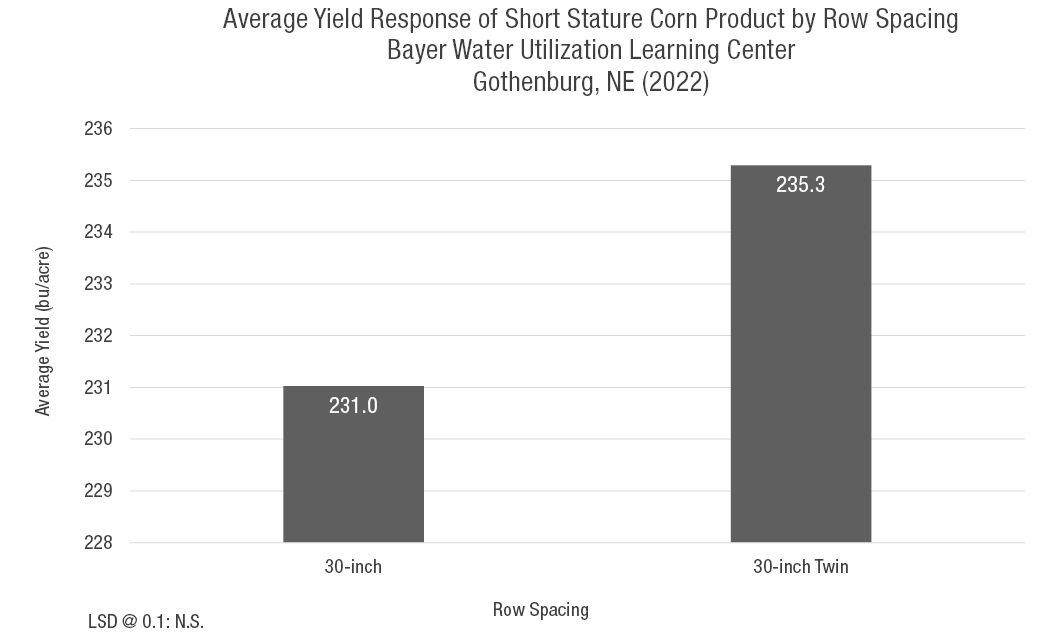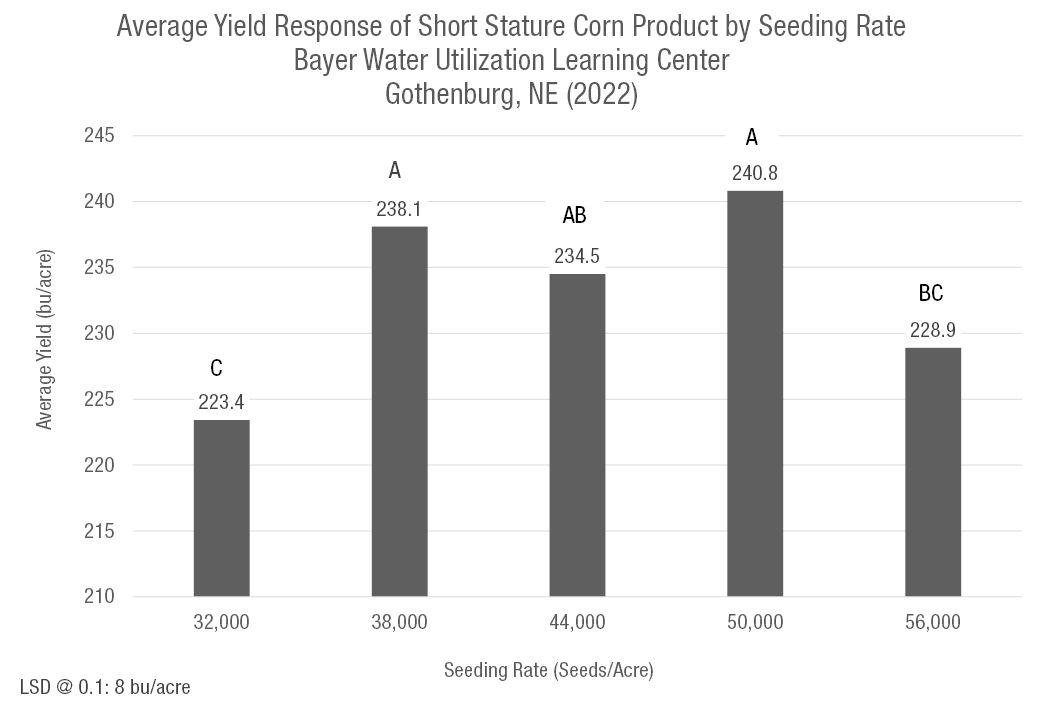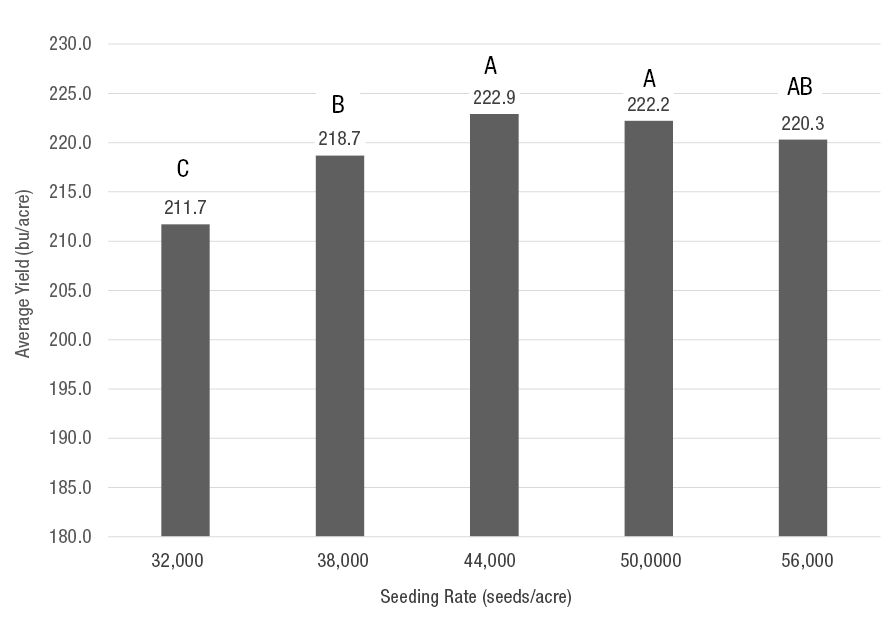Row Spacing and Seeding Rate Effects on Short Stature Corn Yields
April 4, 2023
TRIAL OBJECTIVE
- Short stature corn products may have the potential to be planted at greater seeding rates than conventional tall corn products because studies have shown a lower risk of stalk lodging.
- The objective of this study was to determine the effect of two different row spacings and five seeding rates on short statured corn yield potential.
RESEARCH SITE DETAILS

- The trial was arranged as a randomized complete block design with four replications and two treatment factors.
- Row Spacing
- 30-inch, 30-inch Twin Row (Two rows, eight inches apart on 30-inch centers)
- Seeding Rates
- 32,000, 38,000, 44,000, 50,000, and 56,000 seeds/acre
- Corn Product
- 112 Relative Maturity (RM) Short Stature Corn Product
- Corn was fully irrigated throughout growing season for a total of nine inches of applied irrigation.
- The trial was strip-tilled on 04/14/2022 and a base fertilizer application of 29 lb of nitrogen (N)/acre, 60 lb of phosphorus (P)/acre, 25 lb of sulfur (S)/acre, and 0.25 lb Zinc (Zn)/acre was strip-till applied.
- Corn was sidedressed with Y-drops on 6/4/2022 with an additional 140 lb of N/acre.
- Weeds were controlled with an herbicide application, but no specialty application was applied.
- Harvest Date
- 11/21/2022, a late harvest date to test corn for late season stalk lodging.
- Total weight, test weight, and moisture content were collected with a plot combine to calculate yield per acre.
UNDERSTANDING THE RESULTS
Row Spacing
- Row spacing did not result in a significant increase or decrease in yield (Figure 1).

Seeding Rate
- Seeding rate resulted in significant differences in average corn yield (Figure 2).
- The short statured corn product planted in the range of 38,000 to 50,000 seeds/acre provided the highest yields; however, there was no significant difference for the seeding rates of 44,000 and 56,000 seeds/acre (Figure 2).
- The lowest average yields of 223.4 and 228.9 bu/acre for the short statured corn product occurred at 32,000 and 56,000 seeding rates, respectively (Figure 2).
- In comparison, a similar Bayer study conducted in 2022 at 53 locations across seven states (IA, IL, IN, NE, MN, MO, OH) looked at the effect of planting density on 3 different precommercial short statured corn products at each location.
- Results were similar in that the short statured corn product planted in the range of 44,000 to 56,000 seeds per acre provided the highest yields. (Figure 3).


KEY LEARNINGS
- Changing seeding rates resulted in significant differences in average corn yield but utilizing either 30-inch or Twin-Row 30-inch row spacings did not influence yield.
- In this trial, the average yields of the irrigated, short statured corn product planted at 38,000, 44,000, and 50,000 seeds/acre were similar.
- Planting the short statured corn product at greater seeding rates, such as 50,000 seeds/acre, delivered higher average yields, but going beyond that led to lower average yields.
- Stalk lodging was not observed in any of the treatments in this trial even at the late harvest date and highest densities.
1214_197002
TRIAL OBJECTIVE
- Short stature corn products may have the potential to be planted at greater seeding rates than conventional tall corn products because studies have shown a lower risk of stalk lodging.
- The objective of this study was to determine the effect of two different row spacings and five seeding rates on short statured corn yield potential.
RESEARCH SITE DETAILS

- The trial was arranged as a randomized complete block design with four replications and two treatment factors.
- Row Spacing
- 30-inch, 30-inch Twin Row (Two rows, eight inches apart on 30-inch centers)
- Seeding Rates
- 32,000, 38,000, 44,000, 50,000, and 56,000 seeds/acre
- Corn Product
- 112 Relative Maturity (RM) Short Stature Corn Product
- Corn was fully irrigated throughout growing season for a total of nine inches of applied irrigation.
- The trial was strip-tilled on 04/14/2022 and a base fertilizer application of 29 lb of nitrogen (N)/acre, 60 lb of phosphorus (P)/acre, 25 lb of sulfur (S)/acre, and 0.25 lb Zinc (Zn)/acre was strip-till applied.
- Corn was sidedressed with Y-drops on 6/4/2022 with an additional 140 lb of N/acre.
- Weeds were controlled with an herbicide application, but no specialty application was applied.
- Harvest Date
- 11/21/2022, a late harvest date to test corn for late season stalk lodging.
- Total weight, test weight, and moisture content were collected with a plot combine to calculate yield per acre.
UNDERSTANDING THE RESULTS
Row Spacing
- Row spacing did not result in a significant increase or decrease in yield (Figure 1).

Seeding Rate
- Seeding rate resulted in significant differences in average corn yield (Figure 2).
- The short statured corn product planted in the range of 38,000 to 50,000 seeds/acre provided the highest yields; however, there was no significant difference for the seeding rates of 44,000 and 56,000 seeds/acre (Figure 2).
- The lowest average yields of 223.4 and 228.9 bu/acre for the short statured corn product occurred at 32,000 and 56,000 seeding rates, respectively (Figure 2).
- In comparison, a similar Bayer study conducted in 2022 at 53 locations across seven states (IA, IL, IN, NE, MN, MO, OH) looked at the effect of planting density on 3 different precommercial short statured corn products at each location.
- Results were similar in that the short statured corn product planted in the range of 44,000 to 56,000 seeds per acre provided the highest yields. (Figure 3).


KEY LEARNINGS
- Changing seeding rates resulted in significant differences in average corn yield but utilizing either 30-inch or Twin-Row 30-inch row spacings did not influence yield.
- In this trial, the average yields of the irrigated, short statured corn product planted at 38,000, 44,000, and 50,000 seeds/acre were similar.
- Planting the short statured corn product at greater seeding rates, such as 50,000 seeds/acre, delivered higher average yields, but going beyond that led to lower average yields.
- Stalk lodging was not observed in any of the treatments in this trial even at the late harvest date and highest densities.
1214_197002
Seed Brands & Traits
Crop Protection
Disclaimer
Always read and follow pesticide label directions, insect resistance management requirements (where applicable), and grain marketing and all other stewardship practices.
©2024 Bayer Group. All rights reserved.